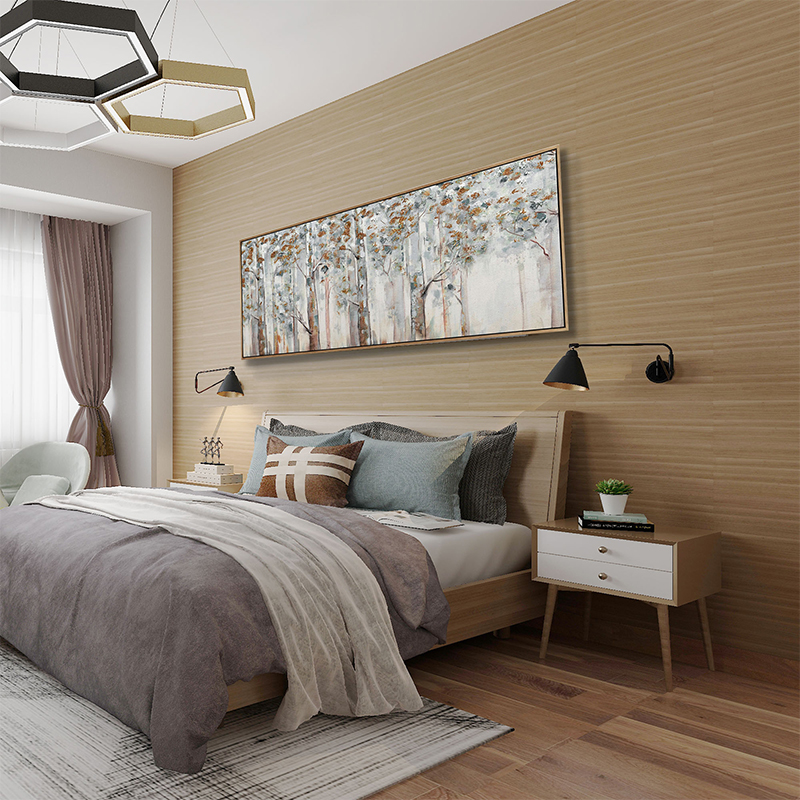In modern interior design, decorative landscape paintings have become more than simple wall décor — they are expressions of calm, balance, and refined taste. Blending natural scenery with artistic composition, these paintings bring the quiet beauty of mountains and rivers into the living space, transforming walls into windows of tranquility.
1. A Modern Interpretation of Landscape Art
Unlike traditional Chinese landscape paintings that focus on philosophy and ink technique, decorative landscape art emphasizes visual harmony and spatial aesthetics. It integrates natural imagery — mountains, water, clouds, and forests — with modern design principles such as minimalism, symmetry, and color balance.
Whether rendered in ink, watercolor, or digital print, each piece captures a dialogue between nature and modern living, helping to create an atmosphere that soothes the mind and enriches the senses.
2. The Power of Visual Calm
A well-chosen landscape painting can completely redefine a room. The soft flow of rivers, the distant silhouettes of mountains, and the mist that blurs horizon lines all create a sense of depth and serenity.
These natural elements evoke a visual rhythm that relaxes the viewer, making them ideal for living rooms, bedrooms, and office spaces. Research in environmental psychology even suggests that nature-inspired artwork reduces stress and enhances focus, making landscape paintings a subtle yet powerful form of emotional design.
3. Balancing Nature and Space
Decorative landscape paintings are highly adaptable to various interior styles:
Modern Minimalism: Simple ink or abstract mountain silhouettes bring purity and calm.
Oriental Elegance: Traditional Shanshui-inspired paintings add cultural warmth and depth.
Contemporary Luxury: Metallic accents or textured canvases highlight sophistication and visual impact.
By selecting the right tone, color, and scale, a landscape painting can serve as the focal point of the entire space, harmonizing architecture, lighting, and furniture design.
4. The Symbolism Behind Mountains and Water
Beyond their aesthetic value, mountains and waters carry symbolic meanings. Mountains represent stability, endurance, and aspiration; water symbolizes flow, vitality, and adaptability. Together, they form a natural equilibrium — a reflection of inner peace and balance in modern life.
This symbolism gives decorative landscape paintings a deeper emotional resonance, turning them into more than just art — they become expressions of a lifestyle philosophy.
5. Materials and Craftsmanship
Modern decorative landscape paintings use diverse materials — canvas, silk, acrylic glass, or metal panels — to achieve different visual effects. High-definition printing technology ensures color accuracy and depth, while hand-painted textures and layered finishes bring tactile realism to every detail.
Many premium pieces combine traditional brushwork with contemporary art techniques, allowing the artwork to complement both classical and modern interiors.
6. Bringing Nature Home
In an age of digital overload, bringing a piece of nature indoors is a way to reconnect with simplicity. A landscape painting does not merely decorate a wall; it creates emotional space — a pause, a breath, a moment of reflection.
Whether displayed in a private residence, hotel lobby, or corporate reception area, these paintings embody the timeless harmony between humans and nature, bridging aesthetics and mindfulness.
Decorative landscape paintings are not just art; they are a visual form of serenity. They speak to the soul through quiet composition and balanced design, transforming interiors into living poetry.
Amid the fast pace of modern life, they remind us to slow down, to breathe, and to find beauty in stillness — just as the mountains stand firm and the rivers flow endlessly forward.

